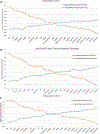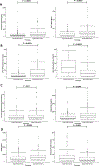Latent class analysis-derived subphenotypes are generalisable to observational cohorts of acute respiratory distress syndrome: a prospective study
- PMID: 34253679
- PMCID: PMC8688287
- DOI: 10.1136/thoraxjnl-2021-217158
Latent class analysis-derived subphenotypes are generalisable to observational cohorts of acute respiratory distress syndrome: a prospective study
Abstract
Rationale: Using latent class analysis (LCA), two subphenotypes of acute respiratory distress syndrome (ARDS) have consistently been identified in five randomised controlled trials (RCTs), with distinct biological characteristics, divergent outcomes and differential treatment responses to randomised interventions. Their existence in unselected populations of ARDS remains unknown. We sought to identify subphenotypes in observational cohorts of ARDS using LCA.
Methods: LCA was independently applied to patients with ARDS from two prospective observational cohorts of patients admitted to the intensive care unit, derived from the Validating Acute Lung Injury markers for Diagnosis (VALID) (n=624) and Early Assessment of Renal and Lung Injury (EARLI) (n=335) studies. Clinical and biological data were used as class-defining variables. To test for concordance with prior ARDS subphenotypes, the performance metrics of parsimonious classifier models (interleukin 8, bicarbonate, protein C and vasopressor-use), previously developed in RCTs, were evaluated in EARLI and VALID with LCA-derived subphenotypes as the gold-standard.
Results: A 2-class model best fit the population in VALID (p=0.0010) and in EARLI (p<0.0001). Class 2 comprised 27% and 37% of the populations in VALID and EARLI, respectively. Consistent with the previously described 'hyperinflammatory' subphenotype, Class 2 was characterised by higher proinflammatory biomarkers, acidosis and increased shock and worse clinical outcomes. The similarities between these and prior RCT-derived subphenotypes were further substantiated by the performance of the parsimonious classifier models in both cohorts (area under the curves 0.92-0.94). The hyperinflammatory subphenotype was associated with increased prevalence of chronic liver disease and neutropenia and reduced incidence of chronic obstructive pulmonary disease. Measurement of novel biomarkers showed significantly higher levels of matrix metalloproteinase-8 and markers of endothelial injury in the hyperinflammatory subphenotype, whereas, matrix metalloproteinase-9 was significantly lower.
Conclusion: Previously described subphenotypes are generalisable to unselected populations of non-trauma ARDS.
Keywords: ARDS; critical care; cytokine biology.
© Author(s) (or their employer(s)) 2022. No commercial re-use. See rights and permissions. Published by BMJ.
Conflict of interest statement
Competing interests: PS declares no competing interests. CSC has received grant funding from the NIH, US Food and Drug Administration, Roche-Genentech, Quantum Leap Healthcare Collaborative, and Bayer Pharmaceuticals and has served as a consultant to Vasomune, Quark, and Gen1e Life Sciences.
Figures





Dataset use reported in
-
ARDS subphenotypes: searching for Rorschach among the roentgenograms?Thorax. 2022 Jan;77(1):2-4. doi: 10.1136/thoraxjnl-2021-217428. Epub 2021 Jul 12. Thorax. 2022. PMID: 34253680 No abstract available.
References
-
- Calfee CS, Delucchi KL, Sinha P, Matthay MA, Hackett J, Shankar-Hari M, McDowell C, Laffey JG, O’Kane CM, McAuley DF, Irish Critical Care Trials G, (2018) Acute respiratory distress syndrome subphenotypes and differential response to simvastatin: secondary analysis of a randomised controlled trial. Lancet Respir Med 6: 691–698 - PMC - PubMed
Publication types
MeSH terms
Substances
Grants and funding
LinkOut - more resources
Full Text Sources
Research Materials
